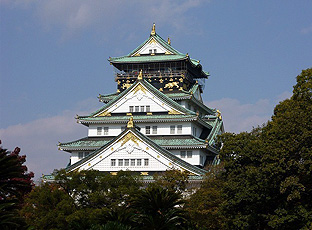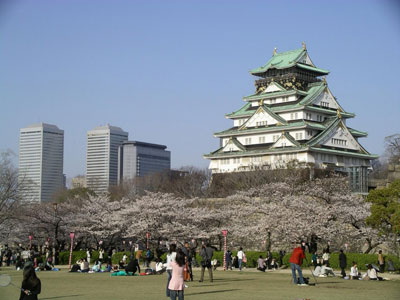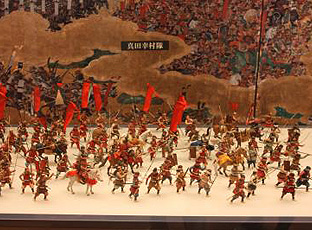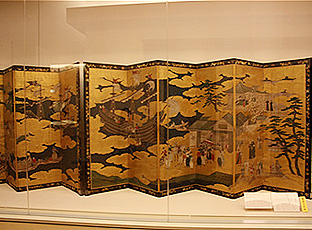
Travel Guide
Introduction
 The largest, most intimidating castle of its time, Osaka Castle was built by Toyotomi Hideyoshi, one of the three great unifiers of Japan. Begun in 1583 and completed in 1597, it was the site of two great battles (Summer and Winter Sieges of Osaka) that cemented the power of the Tokugawa Shogunate, which lasted for 250 years.
The largest, most intimidating castle of its time, Osaka Castle was built by Toyotomi Hideyoshi, one of the three great unifiers of Japan. Begun in 1583 and completed in 1597, it was the site of two great battles (Summer and Winter Sieges of Osaka) that cemented the power of the Tokugawa Shogunate, which lasted for 250 years.
Osaka Castle is a historic landmark comprising 13 structures on the grounds of Osaka Castle Park, which covers about 250 acres in the heart of the second-largest city, Osaka, in Japan. Osaka Castle is a hill top style Japanese castle. The main tower features an observation deck at the top floor and a museum inside where you can find a large variety of historical materials and displays.
In the spring, you can see about 600 cherry trees, including someyosyino in Nishiomaru Garden. Also, about 95 kinds of Japanese apricot flowers, 1,250 trees in total, bloom in Ume Grove, and in Omoide-no-mori (Grove of Remembrance), you can enjoy beautiful autumn colored leaves.
At night Osaka Castle is illuminated making an outstanding sight which can be seen from a great distance.
One of the charms of Osaka Castle is the beauty of its stone wall. Reportedly, there are 40,000 rocks in the wall. Legend has it that powerful daimyo from all parts of Japan competed in carrying the large rocks to display their loyalty to the Toyotomi hegemon. The steep walls which rise close to 30 meters high are made of huge blocks of stone that were transported to Osaka from quarries over 100 km away. The sheer height of the walls and the wide moats they rise above the surrounding plane to make for a grand sight that can be matched by no other castle in Japan. The dolphins on the roof, the ornamental roof tiles and reliefs carved in the shape of tigers are all gilded with gold.
Even though the main tower of Osaka Castle was reconstructed in 1931, there still remains thirteen key parts of the Osaka Castle complex in original condition that are so significant that the Japanese Government has designated them to be Important Cultural Properties. Some of the remaining key parts are Otemon Gate, Tamon Turret, Sengan Turret, Enshogura Gunpowder Magazine and three sections of castle wall all located around Otemon Gate. The whole of the Osaka Castle complex has been designated as a Special National Historic Site.
History
 The construction of Osaka Castle started in 1583 on the former site of the Ishiyama Honganji Temple, which had been destroyed by Oda Nobunaga thirteen years earlier. Toyotomi Hideyoshi intended the castle to become the center of a new, unified Japan under Toyotomi rule. It was the largest castle at the time. In 1597 construction was completed and Hideyoshi died. Osaka Castle passed to his son, Toyotomi Hideyori.
The construction of Osaka Castle started in 1583 on the former site of the Ishiyama Honganji Temple, which had been destroyed by Oda Nobunaga thirteen years earlier. Toyotomi Hideyoshi intended the castle to become the center of a new, unified Japan under Toyotomi rule. It was the largest castle at the time. In 1597 construction was completed and Hideyoshi died. Osaka Castle passed to his son, Toyotomi Hideyori.
In 1600 Tokugawa Ieyasu defeated his opponents at the Battle of Sekigahara, and started his own bakufu in Edo. In 1614 Tokugawa attacked Toyotomi in the winter, starting the Siege of Osaka. Although the Toyotomi forces were outnumbered approximately two to one, they managed to fight off Tokugawa's 200,000-man army and protect the castle's outer walls. Tokugawa had the castle's outer moat filled, negating one of the castle's main outer defenses.
During the summer of 1615, Hideyori began to restore the outer moat. Tokugawa, in outrage, sent his armies to Osaka Castle again, and routed the Toyotomi men inside the outer walls on June 4. Osaka Castle fell to Tokugawa, and the Toyotomi clan perished.
In 1620, the new heir to the shogunate, Tokugawa Hidetada, began to reconstruct and re-arm Osaka Castle. He built a new elevated main tower, five stories on the outside and eight stories on the inside, and assigned the task of constructing new walls to individual samurai clans. The walls built in the 1620s still stand today, and are made out of interlocked granite boulders without mortar. Many of the stones were brought from rock quarries near the Seto Inland Sea, and bear inscribed crests of the various families who contributed them.
In 1660, lightning ignited the gunpowder warehouse and the resulting explosion set the castle on fire. In 1665, lightning struck and burnt down the main tower. In 1843, after decades of neglect, the castle got much-needed repairs when the bakufu collected money from the people of the region to rebuild several of the turrets.
In 1868, Osaka Castle fell and was surrendered to anti-bakufu imperial loyalists. Much of the castle was burned in the civil conflicts surrounding the Meiji Restoration.
Under the Meiji government, Osaka Castle became part of the Osaka Army Arsenal (Osaka Hohei Kosho) manufacturing guns, ammunition, and explosives for Japan's rapidly expanding Western-style military.
In 1928, the main tower was restored after the mayor of Osaka concluded a highly successful fund-raising drive.
During World War II, the arsenal became one of the largest military armories, employing 60,000 workers. Bombing raids targeting the arsenal damaged the reconstructed main castle tower and, on August 14, 1945, destroyed 90% of the arsenal and killed 382 people working there.
In 1995, Osaka's government approved yet another restoration project, with the intent of restoring the main tower to its Edo-era splendor. In 1997, restoration was completed. The castle is a concrete reproduction (including elevators) of the original and the interior is intended as a modern, functioning museum.


Travel Advice
Sightseeing
- A number of organizations, such as JTB and Kinki Nippon Tourist, offer guided tours of Osaka Castle in English and other languages, either as the primary destination or part of longer tours. Organized bus tours of the city almost always visit the castle, as do boat tours, since the structure is near a branch of the Yodo River. Walking tours of Osaka, which often combine walking and subway rides, usually visit the castle as well.
- Visitors can try on a helmet, surcoat and kosede kimono, and have your photograph taken at the second floor of the main tower.
Visit
| Address | 1-1, Osakajo, Chuo-ku, Osaka-shi, Osaka | |
| Phone | 06-6941-3044 | |
| Admission | Adult: 600 yen (Groups 540 yen) | Adult: over 15 Groups: 15 to 99 |
| Hours | 09:00 to 17:00 | Entry until 30 minntes before closing |
| Closed | December 28 to January 1 | |
| Duration | 40 minutes | |
| Getting There | By Train 20 minute walk from No.1-B exit of Tanimachi Yonchome Station on subway Tanimachi Line. 20 minute walk from No.3 exit of Tenmabashi Station on subway Tanimachi Line. 20 minute walk from No.9 exit of Tanimachi Yonchome Station on subway Chuo Line. 20 minute walk from No.1 exit of Mori-no-miya Station on subway Chuo Line. 20 minute walk from No.3-B exit of Mori-no-miya Station on subway Nagahori Tsurumi-ryokuchi Line. 15 minute walk from Mori-no-miya Station or Osakajo-koen on JR Osaka Kanjosen. 15 minute walk from Osakajo-kitazume Station on JR Osaka Tozai Line. 15 minute walk from Tenmabashi Station on Keihan Honsen Line. By Car Take Hanshin Expressway to the Hoenzaka exit or Mori-no-miya exit. It is approximately 5 minutes from exit. |
|
| Parking | Paid parking available | |

